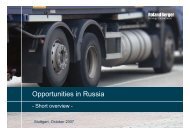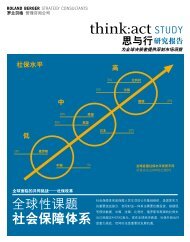Scenario planning â how to find the right strategy at ... - Roland Berger
Scenario planning â how to find the right strategy at ... - Roland Berger
Scenario planning â how to find the right strategy at ... - Roland Berger
Create successful ePaper yourself
Turn your PDF publications into a flip-book with our unique Google optimized e-Paper software.
Study 17<br />
A polarized world with high resource<br />
intensity and high protectionism<br />
Enterprises in resource-rich countries prosper <strong>at</strong> <strong>the</strong> expense of<br />
large multin<strong>at</strong>ionals. This shift in economic power leaves resourcepoor<br />
economies such as Western Europe and Japan scrambling<br />
<strong>to</strong> source raw m<strong>at</strong>erials. Countries with n<strong>at</strong>ural resources focus on<br />
production technologies, while resource-poor countries design<br />
and develop altern<strong>at</strong>ive m<strong>at</strong>erials. Resource-rich regions,<br />
especially those with large regional markets and technologically<br />
advanced economies, flourish. These include North America, China,<br />
India, Russia, Brazil, Australia and <strong>the</strong> Middle East. But Japan<br />
and Western Europe lose out in this future vision because high<br />
protectionism inhibits trade in resources.<br />
Developing regions' demand for steel and cement soars as<br />
countries pursue ambitious agendas <strong>to</strong> modernize infrastructures<br />
and c<strong>at</strong>ch up with <strong>the</strong> developed world. Substantial chemical<br />
production shifts <strong>to</strong> China, Russia and <strong>the</strong> Middle East as<br />
manufacturers move closer <strong>to</strong> cus<strong>to</strong>mers and markets. Due <strong>to</strong><br />
high protectionism, developed n<strong>at</strong>ion manufacturers <strong>find</strong> it<br />
difficult <strong>to</strong> install production facilities in <strong>the</strong> new emerging<br />
markets.<br />
Energy remains a core industry domin<strong>at</strong>ed by fossil fuels. The<br />
mining sec<strong>to</strong>r invests in underground extraction as minerals<br />
become harder and harder <strong>to</strong> <strong>find</strong>. The au<strong>to</strong>motive sec<strong>to</strong>r suffers<br />
from market fragment<strong>at</strong>ion, and protectionism signals <strong>the</strong> end<br />
of global brand cars like <strong>the</strong> Ford Focus. European manufacturers<br />
lose significant market share as emerging countries focus on<br />
regional car brands.<br />
Securing access <strong>to</strong> n<strong>at</strong>ural resources<br />
(or cooper<strong>at</strong>ing with organiz<strong>at</strong>ions for indirect access)<br />
Optimizing costs by exploiting resources cost-effectively<br />
<strong>to</strong> ensure competitively priced products<br />
Restructuring oper<strong>at</strong>ions (incl. small-scale plants)<br />
<strong>to</strong> supply local/regional markets<br />
Forging str<strong>at</strong>egic rel<strong>at</strong>ions with local emerging market<br />
suppliers <strong>to</strong> provide technologies and services for<br />
<strong>the</strong> booming infrastructure sec<strong>to</strong>r<br />
Taking marketing actions <strong>to</strong> establish a regional brand<br />
among emerging market suppliers





